Mar 23, 2010
Moving in with Mum - That Other Vietnamese Thing
Mar 19, 2010
That Vietnamese Thing
Or should that be: ARRRGGHHH! Family.
Those of us bethrothed to a lady of another nationality have not only the Mars/Venus collision to deal with but also the at times stupendous cultural differences to hurdle and manage. Understanding women is the holy grail of any man's life. Cultural 'clashes' however are certianly not always down to the wife and the wife alone, the accompanying family can have a large part to play in our headaches ( I will use the possessive pronoun 'our' representing all my bretheren in this situation).
In my experience potentially the most explosive sitauations are tiny misunderstandings. Things so easily get lost in translation, a sea of idioms, facial expressions and lost sarcasm. Never communicate important matters in writing. In the larger, longer term picture - we have to accept that there are some things about the Vietnamese that a foreigner may never understand - and that's not a bad thing either. For some it adds to the mystery and excitement. To others, it mounts into a burden of frustration. I know of many who have split from their foriegn spouses - but statistically we know of the divorce rates in western countries and should image the rate of divorce in mixed marriages is no higher if not much less. This article talks about it a little.
Now add children.

Our little babies come into the world and bless em they take over our lives and we watch them grow with joy. Parenting is a contentious issue in any household, never mind one that has to share the mindset of two continents. It starts from birth. Vietnamese traditions with regards to the birth of a child are not for the fainthearted and include the mother moving back in with her family, not leaving the house for a month and also not showering. Amongst many, many others. Personally, I think it all a load of nonsense with no basis in reality, but that's an opinion. I would have struggled to go along with it all if I was in a traditional family. Chi is also not worried or concerned with 'traditions' of this nature and although she has a large family, they are not close. Furthermore we had Louisa in England, away from all that cultural interference that, I am sure, just adds to the stress of the new mother who just wants to be left alone with her new baby. For this, Chi was doubly glad. It was a nice start. Others suffer the brutal onslaught of aunts and nannies and grandmothers storming the poor little thing and dicatating the environment and conditions of the first weeks and months. I guess it all depends on your family situation, but I'd imagine most westerners come to a compromise with thier adopted families - as in, when to back the expletive away from my little son/daughter and let me do it.
As soon as we returned to Nam with our 7 month old daughter under our arm the 'advice' began. Two tendancies the Vietnamese seem to have towards babies. One is to gorge them on food - gigantic bottles of formula milk being shoved into their mouths. When they should be moving onto solid foods (natures hint is the teeth she provides), they tend to be force fed bottles of liquid food as well, even until they are 2 or older. Louisa has been chewing on carrots and eating rice since she was younger then a year old. Concerned aunts seemingly try and grind Chi down by saying that Louisa is 'too thin' just because she is not as 'plump' as all the other babies. You can see them with a big bottle of food and a small towel hidden behind their backs just desperate to shove the whole lot down her throat and fatten her up. Well, she looks OK to me. Proud to say, 100% breast fed till this very day.
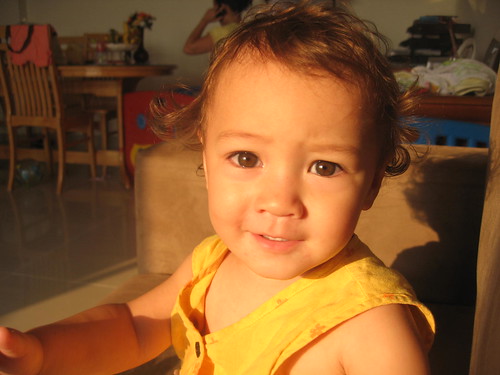
Taking a walk in the park and a Vietnamese father in broken English asks me when Lou started to run around like a maniac, as she was at the time. I told him she started walking between nine and ten months old. Rather pitifully he looked at his 13 month year old son who still could only sit on his bum. 'What kind of milk does she drink'? he asked me, as if all he needed to do was change his brand and suddenly his son would be up and about. Sure, children develop at different speeds, but absolutely no doubt about it, the environment you create for them has a massive impact as well. And this is point number two. We call it mollycoddling. Overprotection. Incessant carrying of the child doesn't help it develop muscles in order to lift its head, then crawl, then grab the furniture and haul itself up and eventually take its first steps. Babies get carried here I feel way too much when they should be left on their backs and then their fronts in a safe space on the floor. It is also, in my opinion, essential that baby smacks his or her head on the table in order to learn that table is hard and it hurts when you smack your head on it. Same goes for eating dirt/flowers/grass/grit/fluff etc. Depriving these sensory learning experiences that wire the brain with a proper understanding of the world impedes development.
I would add my own disclaimer - T.V. This flickering, confusing and noisy instrument has no educational benefit for young children - yes, even if it is on Disney channel. What it does do is interfere with the development of the area of the brain that handles attention - and the ability to hold attention. Whilst the child is staring hypnotised at the machine it is missing out on the more important happenings around it such as watching and hearing the conversations of adults in the room - amongst the many health problems associated with over exposure to TV is attentional disorders and speech problems. Anyone wants a copy of this book, mail me. I digress, TV is by no means an exclusively Vietnamese problem.
Hopefully I've explained some of the pitfalls and tribulations involved in a mixed marriage and raising children within one, and some of the irritations I have come across being a father in Vietnam. All stereotypes within this post must be forgiven for the sake of the whole.
Finally, here's our daughter Louisa, 16 months old, with her latest trick, making herself dizzy when the music comes on...
Mar 13, 2010
Asian Correspondent
What to do if you have 24 hours
A whistle-stop one day tour should focus on getting a feel for this vibrant city. The main attractions are all central and easy to see on foot or by taxi.
Sample the atmosphere - Most of the city is up by 6am, so this a great time for a wander. Pick up a steaming bowl of Pho, the traditional noodle soup breakfast, from any popular street-side stall.
Ben Thanh market - Although ‘touristy’, most definitely an authentic
See the Notre-Dame Cathedral, a replica of the Parisian original, set in a picturesque square in the heart of the city.
The municipal Post Office, directly adjacent to the church and a tourist attraction in its own right, constructed by the French a hundred years ago in the Gothic style.
Reunification Palace, a place with much historic significance being the site of the 1975 hand over of power of Southern Vietnam. War rooms in the basement remain untouched with interesting maps pinned on the walls and a network of offices still furnished with equipment.
Best of the Rest
For those wishing to dig a little deeper, there is much than museums and architecture. The city’s Chinese area, known as ‘Cholon’, is a popular half day trip. Sitting in the east of the city, it is resplendent with traditional Chinese trading shops, markets and most of all, temples. The city offers a number of worthwhile museums, the most notorious of which being the
Hidden Gems
In a city of such noise and traffic, a green oasis is much sought after – and the residents of HCMC take pride in their parks. One of the best is named ‘Gia Dinh’, a 10 minute ride from the airport. Huge trees, immaculate flower beds and romantic walkways make this one of the best parks in the city. The botanical gardens (also home to Saigon Zoo) is another interesting stroll and a retreat from the heat under various tropical foliage.
Accommodation
The backpacker’s quarter is known by the name of one of its streets, Pham Ngu Lao, but is spread out over the surrounding streets as well. It is home to a vast collection of budget guesthouses and a handful of midrange hotels. Prices here start from $10 per night or less for a single room with a fan, increasing up to $40 per night. Rooms come in all shapes and sizes, and for those traveling with a family there are some real bargains to be had. Mid-range hotels in the area charge from $50-$100 per night and have some facilities available including breakfast.
The city center houses the bulk of the high end hotels, names such as Park Hyatt, Sheraton, Caravelle and InterContinental, as well as
The city houses a wide variety of cuisine from street food to Spanish Tapas (try Pacharan on Hai Ba Trung), from fine dining to goat stew. Eating really depends on your budget and your desire. Most of the restaurants in the backpacker ghetto have a good combination of Vietnamese and Western items on the menu for a reasonable price - Try Café 333 on De Tham. The ‘best’ (most expensive) eateries are dotted around District 1.
Entertainment wise, there’s the always reliable and atmospheric Irish Bar,
Retail
Almost all shopping centers cater for tourists. The best places to look are in
Transport
Mar 6, 2010
Bitexco Tower, Ho Chi Minh City

August 29th 2009
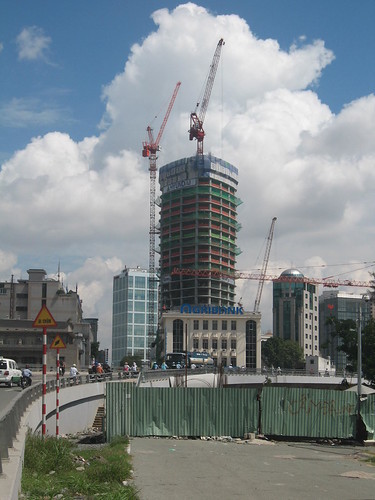
September 19th 2009
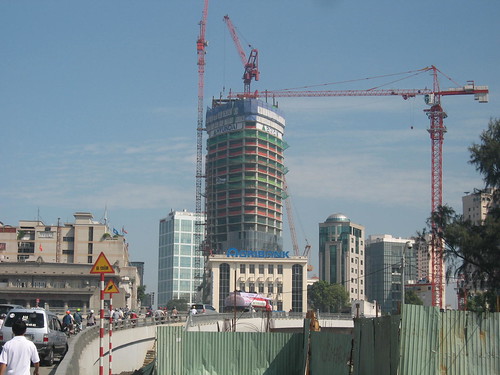
November 14th 2009

March 5th 2010
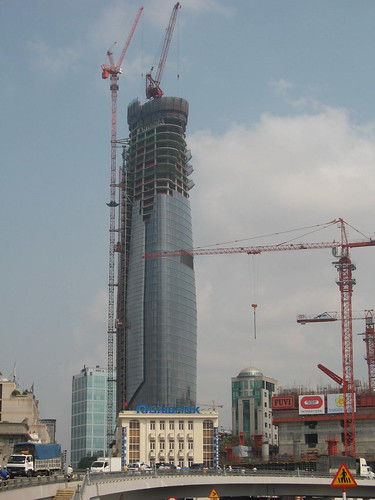
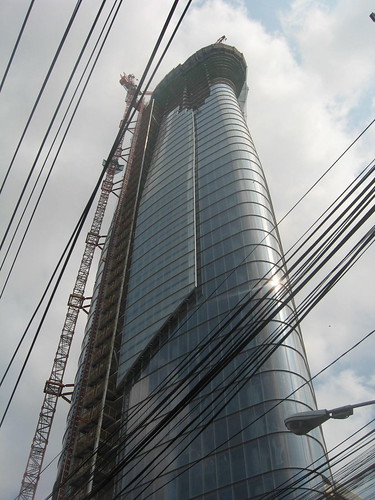
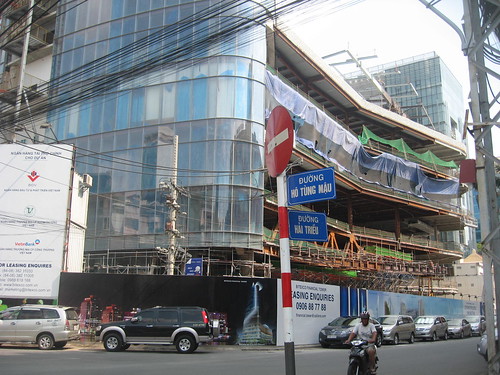
Two fellow Saigon Raiders are working on this project, one being the manger of the entire thing. There is a helipad going on the 54th floor (I think 54) scheduled for April. It has been built and assembled in Korea, will be dissembled and shipped before being reassembled piece by piece as it is constructed from the side of the building.
Although it isn't the Abraj Al Bait, but it is already dominating the HCMC skyline!



